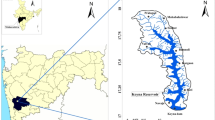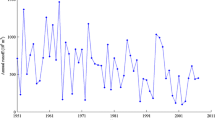Abstract
High accuracy forecasting of medium and long-term hydrological runoff is beneficial to reservoir operation and management. A hybrid model is proposed for medium and long-term hydrological forecasting in this paper. The hybrid model consists of two methods, Singular Spectrum Analysis (SSA) and Auto Regressive Integrated Moving Average (ARIMA). In this model, the time series of annual runoff are first decomposed into several sub-series corresponding to some tendentious and periodic motions by using SSA and then each sub-series is predicted, respectively, through an appropriate ARIMA model, and lastly a correction procedure is conducted for the sum of the prediction results to ensure the superposed residual to be a pure random series. The annual runoff data of two reservoirs in China are analyzed as case studies. The results have been compared with the predictions made by ARIMA and Singular Spectrum Analysis-Linear Recurrent Formulae (SSA-LRF). It is shown that hybrid model has the best performance.
Similar content being viewed by others
References
Akaike H (1974) A look at the statistical model identification. IEEE Trans Automat Contr 19(6):716–723
Barth JAC (2005) AquaTerra-integrated modeling of the river-sediment-soil-groundwater system; advanced tools for the management of catchment areas and river basins in the context of global change. HarmoniCA. Newsletter
Biliuhe Reservoir Management Bureau (2008) Control data of Biliuhe Reservoir. Biliuhe Reservoir Management Bureau, Dalian (In Chinese)
Box GEP, Jenkins G (1970) Time series analysis, forecasting and control. HoldenDay, San Francisco
Broomhead DS, King GP (1986) Extracting qualitative dynamics from experimental data. Physica D 20:217–236
Chatfield C (1996) The analysis of time series: an introduction. Chapman and Hall, New York, p 283
Dahuofang Reservoir Management Bureau (2009) Control data of dahuofang reservoir. Dahuofang Reservoir Management Bureau, Fushun (in Chinese)
Dong SH, Zhou HC, Xu HJ (2004) A forecast model of hydrologic single element medium and long-period based on rough set theory. Water Resour Manag 18:483–495
El-Shafie A, Taha MR, Noureldin A (2007) A neuro-fuzzy model for inflow forecasting of the Nile river at Aswan high dam. Water Resour Manag 21(3):533–556
Elsner JB, Tsonis AA (1997) Singular spectrum analysis: a new tool in time series analysis. Plenum, New York
Fernando DAK, Jayawardena WA (1994) Generation and forecasting of monsoon rainfall data. In: Proceedings of the 20th WEDC conference, Colombo, Sri Lanka, pp 310–313
Fraedrich K (1986) Estimating the dimension of weather and climate attractors. J Atmos Sci 43:419–432
Ghil M, Vautard R (1991) Interdecadal oscillations and the warming trend in global temperature time series. Nature 350:324–327
Golyandina N, Nekrutkin V, Zhigljavsky A (2001) Analysis of time series structure: SSA and related techniques. Chapman and Hall/CRC, New York
Hassani H, Heravi S, Zhigljavsky A (2009) Forecasting European industrial production with singular spectrum analysis. Int J Forecast 25(1):103–118
Kişi Ö (2008) River flow forecasting and estimation using different artificial neural network techniques. Hydrol Res 39(1):27–40
Kumar DN, Raju KS, Sathish T (2004) River flow forecasting using recurrent neural networks. Water Resour Manag 18(2):143–161
Lawrance AJ, Kottegoda NT (1977) Stochastic modeling of riverflow time series. J R Stat Soc A 140(1):1–47
Legates DR, McCabe GJ Jr (1999) Evaluating the use of “goodness-of-fit” measures in hydrologic and hydroclimatic model validation. Water Resour Res 35(1):233–241
Lewis PAW, Ray BK (2002) Nonlinear modeling of periodic threshold autoregressions using TSMARS. J Time Ser Anal 23(4):459–471
Lisi F, Nicolis O, Sandri M (1995) Combination of singular spectrum analysis and auto regressive model for short term load forecasting. Neural Process Lett 2(4):6–10
Marques CAF, Ferreira JA, Rocha A, Castanheira JM, Melo-Goncalves P, Vaz N, Dias JM (2005) Singular spectrum analysis and forecasting of hydrological time series. In: Meeting of the European-Union-of-Geosciences, 2005, Vienna, Austria
Ministry of Water Resources (2000) SL250–2000, Standard for hydrological information and hydrological forecasting. Ministry of Water Resources, Beijing
Salas JD, Delleur JW, Yevjevich V, Lane WL (1980) Applied modeling of hydrologic time series. Water Resouces, Littleton, p 484
Sivapragasam C, Liong SY, Pasha MFK (2001) Rainfall and discharge forecasting with SSA-SVM approach. J Hydroinform 3(7):141–152
Vahabie AH, Yousefi MMR, Araabi BN, Lucas C, Barghinia S (2007) Combination of Singular Spectrum Analysis and Autoregressive Model for short term load forecasting. 2007 IEEE LAUSANNE POWERTECH, pp 1090–1093.
Vautard R, Ghil M (1989) Singular spectrum analysis in nonlinear dynamics, with applications to paleoclimatic time series. Physica D 35:395–424
Vautard R, Yiou P, Ghil M (1992) Singular spectrum analysis: a toolkit for short noisy and chaotic signals. Physica D 58:95–126
Wang BD (1994) A fuzzy maths method on hydrologic long and medium-term forecast. Dalian University of Technology Press, Dalian, pp 87–96 (in Chinese)
Yevjevich V (1972) Stochastic process in hydrology. Water Resouces, Littleton
Yiou P, Baert E, Loutre MF (1996) Spectral analysis of climate data. Surv Geophys 17:619–663
Yurekli K, Kurunca A, Ozturkb F (2005) Application of linear stochastic models to monthly flow data of Kelkit Stream. Ecol Model 183:67–75
Zhu YY, Zhou HC (2009) Rough fuzzy inference model and its application in multi-factor medium and long-term hydrological forecast. Water Resour Manag 23(3):493–507
Author information
Authors and Affiliations
Corresponding author
Rights and permissions
About this article
Cite this article
Zhang, Q., Wang, BD., He, B. et al. Singular Spectrum Analysis and ARIMA Hybrid Model for Annual Runoff Forecasting. Water Resour Manage 25, 2683–2703 (2011). https://doi.org/10.1007/s11269-011-9833-y
Received:
Accepted:
Published:
Issue Date:
DOI: https://doi.org/10.1007/s11269-011-9833-y




